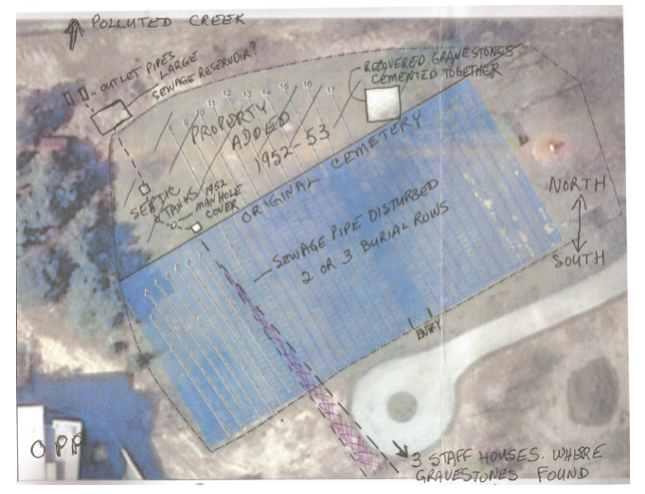Unfinished Work
“The HRC Cemetery is sacred ground that has been desecrated by a septic system through it and to the people laid to rest there. They can't speak but survivors can!”
INSTALLATION OF SEPTIC SYSTEM AND
Removal of Gravestones
The Ontario government proceeded with plans to do a superficial facelift to this cemetery in the fall of 2014. The survivors of HRC wanted a voice in these plans. They also wanted full disclosure from the Ministry of Community and Social Services (MCSS) of documents related to the cemetery that have not been made public. Since then the government has proceeded without either input or approval from the survivors on implementing major changes to the cemetery. They replaced the fence as promised and built a new accessible entrance. However, they have also constructed end row markers with inaccurate information about who and how many are buried in particular rows. This has been part of a continued cover up about two very significant issues in the cemetery’s history.
We believe the gravestones were removed at the same time the sewage system was installed - 1952. In part, because the sewage system disturbed many of the graves but they didn’t simply remove the gravestones over the disturbed graves but 100’s more to obscure what had been done. The blasphemy was that the sewage system was installed to service three farm houses where the farm managers lived and the gravestones were used to make walkways and patios for these very same farm houses.
This 1941 HRC drawing shows tight, evenly spaced rows of graves (blue area) superimposed on an aerial photo of the cemetery. This diagram does not show a small lane where the government says “a utility pipe was installed.” So far no government document has described the exact location or date of the sewage system pipe installation leaving us to believe that many graves were disturbed and that fact is not being addressed. The GPR data should clearly show large pipes such as are in the cemetery yet MCSS has only produced dotted lines drawn on maps that indicate where they ‘think’ the pipes are.
The late Jerry Melbye PhD, one of Canada’s premiere forensic anthropologists, offered to conduct an investigation of the septic system free of charge, but was turned down by the Government of Ontario.
In 2017 the Government of Ontario moved forward with plans to “memorialize” the cemetery at the Huronia Regional Centre, despite having no input from survivors of the institution. Part of this plan included “row end markers,” which supposedly contained the names of those buried in rows which were unmarked or marked only with numbers. Survivors and their supporters expressed great concern with this plan. Due to poor record keeping and missing markers, there is no way to know who is buried in the cemetery and which rows they may be buried in, or even where those rows may be located. Remember Every Name requested that the row end markers be replaced with a single memorial wall with the names of everyone known to be buried at the cemetery, but were ignored.
When the memorials were erected they contained numerous errors, contradicting historical records and the government’s own reports. In some cases, different plaques contradicted each other. In response to the poor job done by the Government of Ontario, survivors sought to create their own memorial for those who lived and died at the Huronia Regional Centre.

